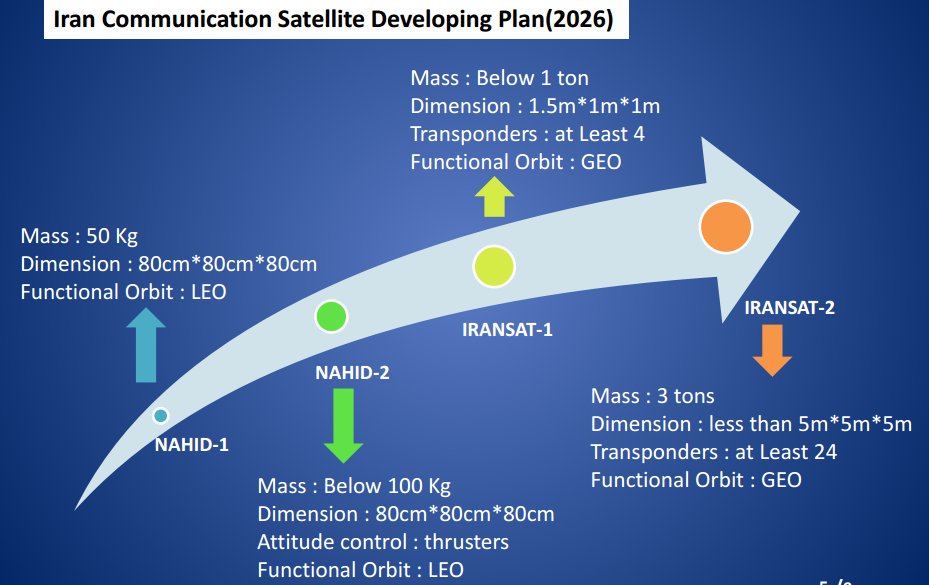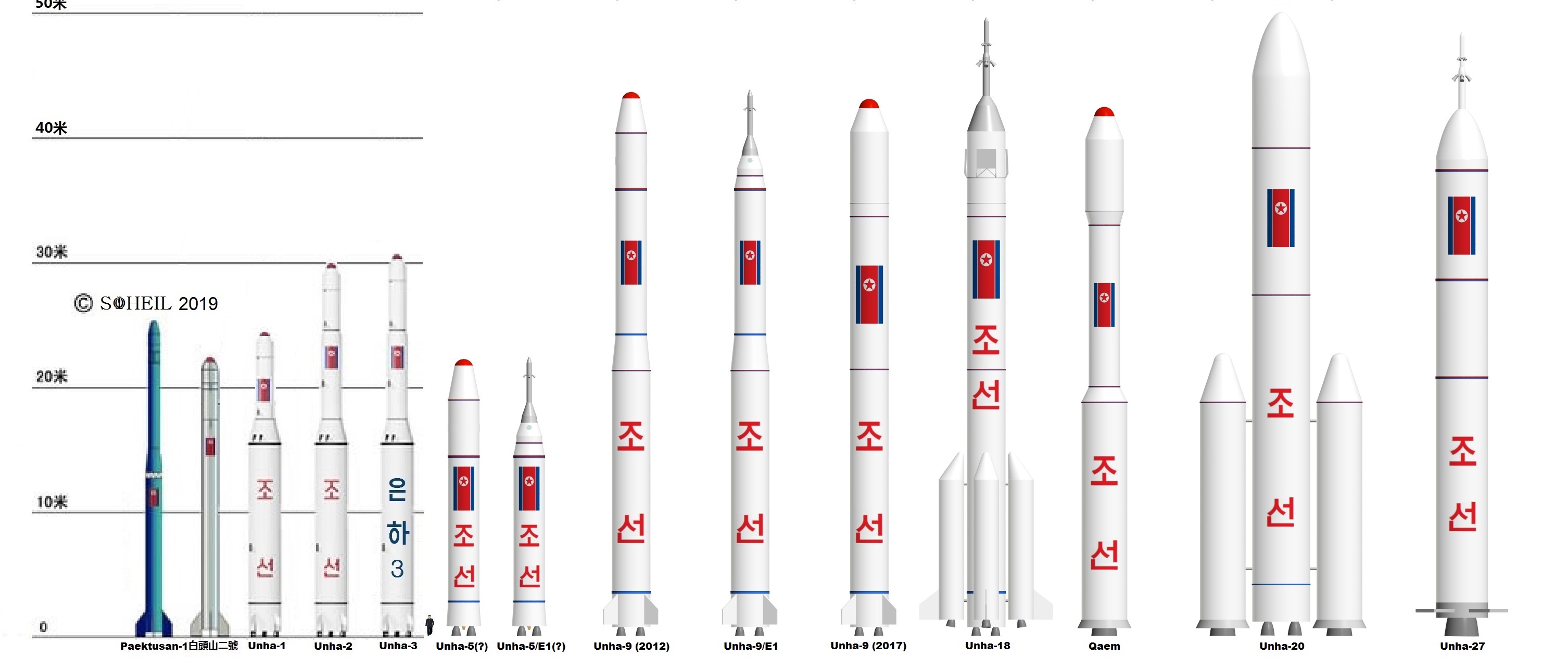Galactic Penguin SST
BANNED

- Joined
- Aug 10, 2017
- Messages
- 1,454
- Reaction score
- 1
- Country
- Location
Iran's First GEO Remote Sensing Satellite
First edited 17 September 2019; Updated 17 September 2019
Table of Contents
1. Introduction
2. First Disclosure of Iran's GEO Remote Sensing Satellite
3. Iran's Adaptive Optics
4. Iran's Orbital Telescope
5. Iran's GEO Space Launcher: Safir-3A/C
6. Iran's Heavy GEO Space Launcher: Safir-4
1. Introduction
The 4.6 ton Gaofen 4, the world's most powerful GEO imaging satellite, was launched on December 28, 2015 from Xichang in China, on a CZ-3B rocket, to a geosynchronous orbit above the Earth.
The GEO orbit of Gaofen 4 means that it can maintain continuous coverage of Chinese territory and surrounding areas. It's also the most powerful GEO satellite, good enough to track aircraft carriers in near real time from space.
GEO satellites constantly stay above a patch of Earth, thus providing constant 24 hour surveillance of a geographic area. By contrast, low earth orbit (LEO) satellites such as the U.S. KH-11 spy satellites are closer to the Earth, so their speed exceeds that of the Earth's rotation (meaning that they cannot maintain continuous surveillance over specific locations). In the Gaofen 4's case, its range of view is a 7,000km by 7,000km box of 49 million square kilometers of Asian land and water in and around China.
The Gaofen 4 is the world's most powerful GEO spy satellite. It has a color image resolution of slightly less than 50 meters (which is enough to track aircraft carriers by their wake at sea) and a thermal imaging resolution of 400m (good for spotting forest fires). It may also have a lower resolution video streaming capacity. Because of its round-the-clock coverage of Chinese territory and near aboard, Gaofen 4 can provide instant coverage of earthquake or typhoon hit areas to support humanitarian relief. It will also allow China to monitor strategic foreign sites such as WMD facilities and naval bases inside its observation box.
As a high orbiting GEO satellite, the Gaofen 4 would be very difficult to attack with anti-satellite weapons.

http://web.archive.org/web/20190917...aws.com/public/WXBXVOS4ETHZLMTKA5SOFLJHWM.jpg
▲ 1. Gaofen 4 GEO Orbit.
http://web.archive.org/web/20190914...ntinues-chinas-great-leap-forward-into-space/
2. First Disclosure of Iran's GEO Remote Sensing Satellite
Putting 'sensing satellite' into orbit of 36,000 kms on agenda
Sep 14, 2019, 5:34 PM
Khorramabad, Sept 14, IRNA - The head of Iran's Space Agency Morteza Barari said on Saturday that the launch of a sensing satellite in the orbit of 36,000 kilometers is on the agenda and three Iranian satellites will be ready to carry out the mission.
Morteza Barari met with faculty and top startups in the province of Lorestan province on Saturday, and noted that the Islamic Republic of Iran has reached a full cycle of space technology with the efforts of its youth, despite 40 years of sanctions.
...
http://web.archive.org/web/20190914...-satellite-into-orbit-of-36-000-kms-on-agenda
http://archive.is/Zbfff
3. Iran's Adaptive Optics
Iran has disclosed discussion on a 3 meter Class Telescope with Adaptive Optics for its National Observatory Program (2011).
4. Iran's Orbital Telescope
The Iranian Space Research Center's Orbital Telescope is a project in its early stages. The feasibility and needs assessment study of this project was carried out.

http://web.archive.org/web/20190805150156if_/http://ipic.su/img/img7/fs/image17.1565017296.jpg ; https://archive.fo/Hgfzf/1ae8342e4b2a9782018bbaac9ccad4485aec46a6.jpg ; https://isrc.ac.ir/getattachment/پژوهشکده-ها/مرکز-فضایی-ایران/image17.jpg ; https://isrc.ac.ir/en-US/پژوهشکده-ها/مرکز-فضایی-ایران ; http://archive.fo/T9L7L
▲ 2. Iran's Orbital Telescope.
5. Iran's GEO Space Launcher: Safir-3A/C
Iran's Communication Satellite Developing Plan 2026 of the Iranian Space Research Center (I.S.R.C.) has revealed its future space launcher's payload capabilities:
• Nahid-1, 50 Kg, LEO, Safir-1 SLV
• Nahid-2, < 100 Kg, LEO, Safir-2 SLV
• IRANSAT-1, 1 ton, GEO, Safir-3A SLV
• IRANSAT-2, 3 tons, GEO, Safir-3C SLV

http://web.archive.org/web/20190801104910if_/https://pbs.twimg.com/media/DVw4DqgXUAEOXQg.jpg ; https://archive.fo/TVRNZ/e148f10050430ae9d3e72e3606acc85cb88610a6.jpg ; https://pbs.twimg.com/media/DVw4DqgXUAEOXQg.jpg:large
▲ 3. Iran's roadmap for communication satellites. From official presentation of the Iranian Space Research Center.
6. Iran's Heavy GEO Space Launcher: Safir-4
The existence of an even more powerful heavy space launcher, able to place 20 tons into LEO, has also been revealed, the Safir-4.
An Iranian version of the North Korean Heavy-Lift Space Launcher Unha-20 has figured prominently in a huge graphic that was displayed during January 2019 in Tehran's Valiasr Square. The billboard was running in conjunction with the 40th anniversary of the Iranian Revolution.

http://web.archive.org/web/20190322040402if_/http://ipic.su/img/img7/fs/proxy_006.1553224298.jpg ; https://archive.fo/LlgII/ff65c5e613f4e6fa6117675b60d31c2b1e1ec5e1.jpg ; http://imagesvc.timeincapp.com/v3/f...es.wordpress.com/2019/01/ddacv.jpg?quality=85 ; https://media.mehrnews.com/d/2019/01/05/4/3004791.jpg; https://www.mehrnews.com/news/4504592/رونمایی-از-جدیدترین-دیوارنگاره-میدان-ولیعصر-با-موضوع-جوانان ; رونمایی از جدیدترین دیوارنگاره میدان ولیعصر با موضوع جوانان ;
▲ 4. 17 January 2019. Note that Shahid Hajj General Hassan Tehrani Moghaddam, the father of Iran's space program is depicted bringing a treasure trove of [North Korean] blueprints to his fellow countrymen!
Below the North Korean equivalent of the Safir-3A (Unha-9) and Safir-4 (Unha-20):

http://web.archive.org/web/20190324234320if_/https://i.imgur.com/YJeN7HI.jpg ; https://archive.fo/8MUj0/5746e1eeabd68c89d76db3e1acc6dd6bb97af820.jpg ; https://defence.pk/pdf/attachments/...7/?temp_hash=70fc9b1656a500388ff26bb0f6ad1834
▲ 5. Artistic representation of the North Korean Unha launchers family, 2019. Outdated as of Mid-February 2019.






First edited 17 September 2019; Updated 17 September 2019
Table of Contents
1. Introduction
2. First Disclosure of Iran's GEO Remote Sensing Satellite
3. Iran's Adaptive Optics
4. Iran's Orbital Telescope
5. Iran's GEO Space Launcher: Safir-3A/C
6. Iran's Heavy GEO Space Launcher: Safir-4
1. Introduction
The 4.6 ton Gaofen 4, the world's most powerful GEO imaging satellite, was launched on December 28, 2015 from Xichang in China, on a CZ-3B rocket, to a geosynchronous orbit above the Earth.
The GEO orbit of Gaofen 4 means that it can maintain continuous coverage of Chinese territory and surrounding areas. It's also the most powerful GEO satellite, good enough to track aircraft carriers in near real time from space.
GEO satellites constantly stay above a patch of Earth, thus providing constant 24 hour surveillance of a geographic area. By contrast, low earth orbit (LEO) satellites such as the U.S. KH-11 spy satellites are closer to the Earth, so their speed exceeds that of the Earth's rotation (meaning that they cannot maintain continuous surveillance over specific locations). In the Gaofen 4's case, its range of view is a 7,000km by 7,000km box of 49 million square kilometers of Asian land and water in and around China.
The Gaofen 4 is the world's most powerful GEO spy satellite. It has a color image resolution of slightly less than 50 meters (which is enough to track aircraft carriers by their wake at sea) and a thermal imaging resolution of 400m (good for spotting forest fires). It may also have a lower resolution video streaming capacity. Because of its round-the-clock coverage of Chinese territory and near aboard, Gaofen 4 can provide instant coverage of earthquake or typhoon hit areas to support humanitarian relief. It will also allow China to monitor strategic foreign sites such as WMD facilities and naval bases inside its observation box.
As a high orbiting GEO satellite, the Gaofen 4 would be very difficult to attack with anti-satellite weapons.

http://web.archive.org/web/20190917...aws.com/public/WXBXVOS4ETHZLMTKA5SOFLJHWM.jpg
▲ 1. Gaofen 4 GEO Orbit.
http://web.archive.org/web/20190914...ntinues-chinas-great-leap-forward-into-space/
2. First Disclosure of Iran's GEO Remote Sensing Satellite
Putting 'sensing satellite' into orbit of 36,000 kms on agenda
Sep 14, 2019, 5:34 PM
Khorramabad, Sept 14, IRNA - The head of Iran's Space Agency Morteza Barari said on Saturday that the launch of a sensing satellite in the orbit of 36,000 kilometers is on the agenda and three Iranian satellites will be ready to carry out the mission.
Morteza Barari met with faculty and top startups in the province of Lorestan province on Saturday, and noted that the Islamic Republic of Iran has reached a full cycle of space technology with the efforts of its youth, despite 40 years of sanctions.
...
http://web.archive.org/web/20190914...-satellite-into-orbit-of-36-000-kms-on-agenda
http://archive.is/Zbfff
3. Iran's Adaptive Optics
Iran has disclosed discussion on a 3 meter Class Telescope with Adaptive Optics for its National Observatory Program (2011).
4. Iran's Orbital Telescope
The Iranian Space Research Center's Orbital Telescope is a project in its early stages. The feasibility and needs assessment study of this project was carried out.

http://web.archive.org/web/20190805150156if_/http://ipic.su/img/img7/fs/image17.1565017296.jpg ; https://archive.fo/Hgfzf/1ae8342e4b2a9782018bbaac9ccad4485aec46a6.jpg ; https://isrc.ac.ir/getattachment/پژوهشکده-ها/مرکز-فضایی-ایران/image17.jpg ; https://isrc.ac.ir/en-US/پژوهشکده-ها/مرکز-فضایی-ایران ; http://archive.fo/T9L7L
▲ 2. Iran's Orbital Telescope.
5. Iran's GEO Space Launcher: Safir-3A/C
Iran's Communication Satellite Developing Plan 2026 of the Iranian Space Research Center (I.S.R.C.) has revealed its future space launcher's payload capabilities:
• Nahid-1, 50 Kg, LEO, Safir-1 SLV
• Nahid-2, < 100 Kg, LEO, Safir-2 SLV
• IRANSAT-1, 1 ton, GEO, Safir-3A SLV
• IRANSAT-2, 3 tons, GEO, Safir-3C SLV

http://web.archive.org/web/20190801104910if_/https://pbs.twimg.com/media/DVw4DqgXUAEOXQg.jpg ; https://archive.fo/TVRNZ/e148f10050430ae9d3e72e3606acc85cb88610a6.jpg ; https://pbs.twimg.com/media/DVw4DqgXUAEOXQg.jpg:large
▲ 3. Iran's roadmap for communication satellites. From official presentation of the Iranian Space Research Center.
6. Iran's Heavy GEO Space Launcher: Safir-4
The existence of an even more powerful heavy space launcher, able to place 20 tons into LEO, has also been revealed, the Safir-4.
An Iranian version of the North Korean Heavy-Lift Space Launcher Unha-20 has figured prominently in a huge graphic that was displayed during January 2019 in Tehran's Valiasr Square. The billboard was running in conjunction with the 40th anniversary of the Iranian Revolution.

http://web.archive.org/web/20190322040402if_/http://ipic.su/img/img7/fs/proxy_006.1553224298.jpg ; https://archive.fo/LlgII/ff65c5e613f4e6fa6117675b60d31c2b1e1ec5e1.jpg ; http://imagesvc.timeincapp.com/v3/f...es.wordpress.com/2019/01/ddacv.jpg?quality=85 ; https://media.mehrnews.com/d/2019/01/05/4/3004791.jpg; https://www.mehrnews.com/news/4504592/رونمایی-از-جدیدترین-دیوارنگاره-میدان-ولیعصر-با-موضوع-جوانان ; رونمایی از جدیدترین دیوارنگاره میدان ولیعصر با موضوع جوانان ;
▲ 4. 17 January 2019. Note that Shahid Hajj General Hassan Tehrani Moghaddam, the father of Iran's space program is depicted bringing a treasure trove of [North Korean] blueprints to his fellow countrymen!
Below the North Korean equivalent of the Safir-3A (Unha-9) and Safir-4 (Unha-20):

http://web.archive.org/web/20190324234320if_/https://i.imgur.com/YJeN7HI.jpg ; https://archive.fo/8MUj0/5746e1eeabd68c89d76db3e1acc6dd6bb97af820.jpg ; https://defence.pk/pdf/attachments/...7/?temp_hash=70fc9b1656a500388ff26bb0f6ad1834
▲ 5. Artistic representation of the North Korean Unha launchers family, 2019. Outdated as of Mid-February 2019.















